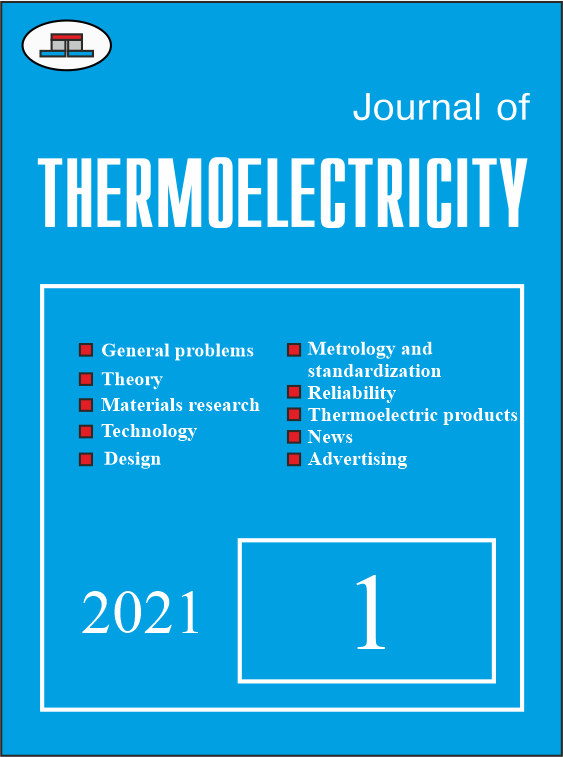Study of structural, thermodynamic, energy, kinetic and magnetic properties of thermoelectric material Lu1-xZrxNiSb
DOI:
https://doi.org/10.63527/1607-8829-2021-1-32-50Keywords:
electronic structure, electrical resistivity, thermopower coefficientAbstract
The crystal and electronic structures, thermodynamic, kinetic, energy and magnetic properties of the thermoelectric material Lu1-xZrxNiSb in the ranges: T=80–400 K, x=0–0.10 were studied. Mechanisms of simultaneous generation of structural defects of acceptor and donor nature are established. It is shown that in the structure of the basic compound LuNiSb there are defects of acceptor nature as a result of vacancies in the crystallographic positions 4a and 4c of Lu and Ni atoms, respectively, which gave rise to acceptor levels (zones) in the band gap εg. Introduction of Zr impurity atoms into the structure of the LuNiSb compound by substitution of Lu atoms in position 4a generates structural defects of donor nature with simultaneous elimination of vacancies in positions 4a and 4c of Lu and Ni atoms, respectively (acceptor levels). The ratio of the concentrations of the available defects of donor and acceptor nature determines the location of the Fermi level εF and the conduction mechanisms in Lu1-xZrxNiSb. The investigated solid solution Lu1-xZrxNiSb is a promising thermoelectric material. Bibl. 15, Fig. 9.
References
Karla I., Pierre J., Skolozdra R.V. (1998). Physical properties and giant magnetoresistance in RNiSb compounds. J. Alloys Compd., 265, 42–48. (DOI: https://doi.org/10.1016/S0925-8388(97)00419-2).
Romaka V.V., Romaka L., Horyn A., Rogl P., Stadnyk Yu., Melnychenko N., Orlovskyy M., Krayovskyy V. (2016). Peculiarities of thermoelectric half-Heusler phase formation in Gd-Ni-Sb and Lu-Ni-Sb ternary systems. J. Solid State Chem., 239, 145–152. (DOI: https://doi.org/10.1016/j.jssc.2016.04.029).
Romaka V.A, Stadnyk Yu., Romaka L., Krayovskyy V., Klyzub P., Pashkevych V., Нoryn A., Garanyuk P. (2021). Synthesis and Electrical Transport Properties of Er1-xScxNiSb Semiconducting Solid Solution.
J. Phys. and Chem. Sol. State, 22(1), 146-152. (DOI: 10.15330/pcss.22.1.146-152).
Stadnyk Yu., Romaka V.A, Нoryn A., Romaka V.V., Romaka L., Klyzub P., Pashkevych V., Garanyuk P. Modeling of Structural and Energetic Parameters of р-Er1-xScxNiSb Semiconductor. J. Phys. and Chem. Sol. State, 22(3), 509-515. (DOI: 10.15330/pcss.22.3.509-515).
Romaka V.V., Romaka L.P., Krayovskyy V.Ya., Stadnyk Yu.V. (2015). Stanidy ridkisnozemelnykh ta perekhidnykh metaliv [Stannides of rare earth and transition metals] Lviv: Lvivska Polytechnika [in Ukrainian].
Romaka V.A., Stadnyk Yu.V., Krayovskyy V.Ya., Romaka L.P., Guk O.P., Romaka V.V., Mykyuchuk M.M., Horyn A.M. (2020). Novitni termochutlyvi materialy ta peretvoriuvachi temperatury [New thermosensitive materials and temperature converters]. Lviv, Lvivska Polytechnika [in Ukrainian].
Anatychuk L.I. (1979). Termoelementy i termoelectricheskiie ustroistva. Spravochnik. [Thermoelements and thermoelectric devices. Reference book]. Kyiv: Naukova dumka [in Russian].
Roisnel T., Rodriguez-Carvajal J. (2001). WinPLOTR: a windows tool for powder diffraction patterns analysis. Mater. Sci. Forum, Proc. EPDIC7 378–381, 118–123.
Akai H. (1989). Fast Korringa-Kohn-Rostoker coherent potential approximation and its application to FCC Ni-Fe systems. J. Phys.: Condens. Matter., 1, 8045–8063.
Moruzzi V.L., Janak J.F., Williams A.R. (1978). Calculated electronic properties of metals. NY: Pergamon Press.
Savrasov S.Y. (1996). Linear-response theory and lattice dynamics: A muffin-tin-orbital approach. Phys. Rev. B, 54(23), 16470–16486.
Momma K., Izumi F. (2008). VESTA: a three-dimensional visualization system for electronic and structural analysis. J. Appl. Crystallogr., 41, 653–658.
Bader R.F.W. (1994). Atoms in Molecules: A Quantum Theory. Oxford: Clarendon press.
Shklovskii B.I. and Efros A.L. (1984). Electronic properties of doped semiconductors NY: Springer; (1979) Moscow: Nauka.
Mott N.F., Davis E.A. (1979). Electron processes in non-crystalline materials. Oxford: Clarendon Press.




